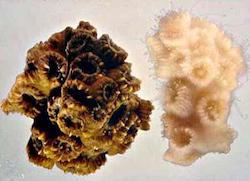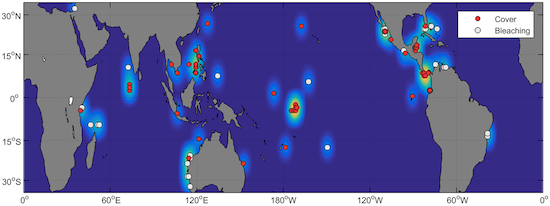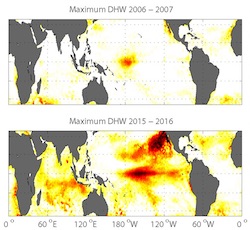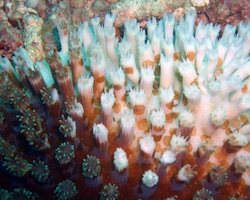
Hot Flashes in the Ocean
What's in the Story?
It’s a clear summer day, and you’ve been playing outside for a while. The sun is beating down on you. You get thirsty. You start to sweat and feel tired. Eventually, you look for some shade or go inside to cool off. You need relief from the intense heat. The air conditioning feels really good on your skin when you go inside. If you don’t escape the heat, eventually you will get sick. In humans, this is called heat stroke.

Coral reefs also get sick when it gets too hot. Reefs are some of the most beautiful and unique ecosystems on Earth. Coral polyps live underwater, so they are very sensitive to the water temperature. Today, the ocean is getting hotter. In the PLOS ONE article, “Global Patterns and Impacts of El Niño Events on Coral Reefs: A Meta-analysis,” scientists studied how short and long-term climate change impacts coral reefs in the Pacific Ocean.
The World of Coral Reefs
Have you heard that coral reefs are alive? You may have seen one in person, at an aquarium, or in a documentary film or TV show. Even if you have never seen one in person, they are still really important.
Each reef is like a living work of art, playing host to a diverse group of underwater animals. Coral reefs cover just 0.1 percent of the Earth’s surface, yet they are home to 25 percent of all life in the ocean. Coral reefs also have a major impact on the economy. These colorful colonies attract tourists around the world.
Corals are very unique creatures because polyps are actually animals. Calcium carbonate, a kind of rock made by corals, holds the reefs together. It works as the corals’ skeleton. Many types of coral contain algae that help keep them alive. The algae give the coral up to 90 percent of its energy.
Threats to Coral Reefs

Although we depend on them, coral reefs are in serious danger. They are dying. When corals get stressed, they push those helpful algae out of their bodies. Then they turn white and die. This is coral bleaching.
Lots of things are bad for coral reefs, including warming temperatures, overfishing, and pollution. Scientists believe the main cause of coral bleaching is warmer ocean temperatures. Two climate patterns, one short-term and one long-term, cause warmer ocean temperatures that hurt coral. The important short-term climate pattern is called El Niño. The other long-term pattern is called climate change, also known as global warming, where Earth is getting hotter.
El Niño is the warming of ocean water in the Pacific Ocean every few years. In El Niño years, the Pacific Ocean water warms up quickly. In La Niña years, the water cools down. The short-term warming during El Niño has a big impact on coral reefs in the Pacific Ocean.

El Niño happens naturally every few years. In the last 35 years (since 1982), it happened eight times. Even though El Niño events are seasonal and temporary, they can have long-term consequences.
Sometimes an El Niño season can be enough to kill off a coral reef permanently. In other cases, the reef can recover with enough time. It depends on local conditions and how often the reef gets exposed to ocean temperatures that are too warm.
Ocean Temperature Trends
In this study, scientists wanted to better understand the impact of El Niño on coral reefs. They heard reports of lots of coral bleaching and areas where 97 percent of corals died. This happened during El Niño in 2015 and 2016. They wanted to confirm this information.
The scientists collected studies from all over the world to look for patterns. This type of study is called a meta-analysis. Specifically, they looked for something that could predict where coral bleaching occurred. They also came up with a way to measure the heat stress for coral at any location on the globe.

They took images from weather satellites to see how hot the ocean is in different places. This is called the sea surface temperature, which is important because most coral reefs live near the surface. Coral bleaching happens when the sea surface temperature gets too hot.
The scientists used temperature data available since 1982. They looked specifically at the 2015-2016 El Niño season in the Pacific. The study confirmed that 2015-2016 was especially damaging to coral reefs. They also came up with explanations for the damage.
The Impact of Climate Change
Even though the warming from El Niño is temporary and short term, it has a big impact because coral reefs are already under a lot of pressure. El Niño’s effects are worse due to long-term climate change.
The temperature of the Earth varies over time. Today many scientists say the Earth’s climate is changing and getting warmer. In addition to El Niño, climate change is also causing ocean temperatures to increase. This is bad news for coral reefs because warmer water can kill them.

Understanding past El Niño effects can help scientists better predict future effects. Scientists say El Niño events will happen more often in the future. They will also be more severe. Climate change will also make the problem worse by increasing ocean temperatures. That will mean more corals dying off due to the heat.
With the dual threat of El Niño and climate change, scientists worry that warmer ocean temperatures could destroy coral reefs forever. Knowing what is happening could help us better protect coral reefs. Some corals may adapt to warmer waters, so this information about changing temperature trends over time will help scientists do more research. That research could help us protect some of the coral reefs.
Additional images via Wikimedia Commons. Sea rod coral image by US Geological Survey. Thumbnail of coral by Ryan McMinds.
Bibliographic details:
- Article: Hot Flashes in the Ocean
- Author(s): Ben Petersen
- Publisher: Arizona State University School of Life Sciences Ask A Biologist
- Site name: ASU - Ask A Biologist
- Date published:
- Date accessed:
- Link: https://askabiologist.asu.edu/plosable/el-nino-coral-reefs
APA Style
Ben Petersen. (). Hot Flashes in the Ocean. ASU - Ask A Biologist. Retrieved from https://askabiologist.asu.edu/plosable/el-nino-coral-reefs
Chicago Manual of Style
Ben Petersen. "Hot Flashes in the Ocean". ASU - Ask A Biologist. . https://askabiologist.asu.edu/plosable/el-nino-coral-reefs
Ben Petersen. "Hot Flashes in the Ocean". ASU - Ask A Biologist. . ASU - Ask A Biologist, Web. https://askabiologist.asu.edu/plosable/el-nino-coral-reefs
MLA 2017 Style

Be Part of
Ask A Biologist
By volunteering, or simply sending us feedback on the site. Scientists, teachers, writers, illustrators, and translators are all important to the program. If you are interested in helping with the website we have a Volunteers page to get the process started.

